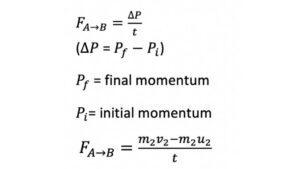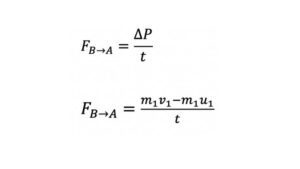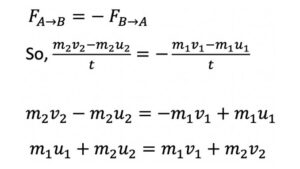Introduction
Sir Isaac Newton discovered the law of conservation of momentum while formulating the laws of motion. The law of conservation of momentum is a direct consequence of Newton’s third law of motion.
When two or more bodies act upon one another then in the absence of an external force, the total momentum of all bodies in the system in a particular direction remains constant. This is known as the law of conservation of momentum.
The law of conservation of momentum states that the total momentum of a closed system does not change, this means that when two objects collide the total momentum of objects before the collision is the same as the total momentum of the objects after the collision.
In an isolated system such as the universe, there are no external forces. For this reason, momentum is always conserved. The application of the law of conservation of momentum is important in the solution of collision problems.
The momentum of particles depends upon two variables: one is the mass of the particles and another is the velocity of the particles.
What is momentum?
Momentum is a measurement of the motion of a moving object. It is measured by the product of its mass and velocity.
P = m v
Here, P = the momentum
m = mass of the moving object
v = velocity of the moving object
Momentum has both magnitude and direction. So, it is a vector quantity.
Unit of momentum
The SI unit is kg.m/sec
Diagram
Types of momentum
There are two types of momentum in physics.
- Linear momentum
- Angular momentum
Linear momentum
The product of the mass and velocity of particles is known as linear momentum. If there is no external force acting on the colliding particles, the linear momentum is conserved.
Angular momentum
The product of the moment of inertia of rotating particles and its angular velocity is called angular momentum. If there is no external torque (A rotational effect of a force) acting on the rotating particle, then the angular momentum is conserved.
Definition of law of conservation of momentum
If the external force acting on a particle is zero, its momentum will remain unchanged.
This theorem is often called the Principle of conservation of momentum. For the case of constant mass, it is equivalent to Newton’s first law.
Example
- Gun and bullet
- Air-filled balloons
Equation
If no external force is applied to the two colliding particles, the particles apply an impulse to each other for a brief moment at the point of contact. The force exerted by the first particle is equal and opposite to the force applied by the second particle on the first particle, according to Newton’s third law of motion.
m1u1 = The momentum of body A, before the collision
m2u2 = The momentum of body B, before the collision
m1v1 = The momentum of body A, after collision
m2v2 = The momentum of body B, after collision
The rate of change of the momentum of body B is given by:

The rate of change of the momentum of body A is given by:

According to Newton’s third law,

This is the equation of the law of conservation of momentum.
Example of laws of conservation of momentum
1. The system of Gun and Bullet
If a bullet is shot from a gun, both the bullet and the gun are initially still, which means the total momentum before firing is zero.
The bullet gains forward momentum when it gets discharged from the bullet.
As per the conservation of momentum, the gun gets regressive momentum.
The mass of the bullet terminated with some velocity.
On the other hand, the mass of the gun gains a retrogressive backward velocity.
Before terminating, the total momentum is zero. so the total momentum after firing is also zero.
2. Air Balloon
The particles of gas move quickly crashing into each other and the walls of the balloon.
Although particles themselves move quicker and slower when they lose or pick up momentum when they collide.
The total momentum of the system remains as before.
Application Laws of conservation of momentum
1. Rocket propulsion
One of the best applications of the law of conservation of momentum is rocket propulsion.
The principle on which rocket propulsion works is based on Newton’s third law of motion.
Rocket carries with it both the fuel and the oxidizing agent necessary for combustion.
As far as the rocket is concerned, the engine of the rocket releases hot burning fuel in the downward direction.
Hence, the gases apply equal and opposite forces and push the rocket in an upward direction.
The fuel is forcibly ejected from the exit such that an equal and opposite reaction occurs.
Before the ejection of the gas from the rocket’s gas chamber, the rocket gains a recoil velocity and acceleration in the opposite direction. This is the result of the conservation of momentum.
(Rocket- A rocket is a device that moves forward by expelling particles of a fuel mixture backward. one of the important uses of the rocket is to put a satellite into an orbit, apart from the interplanetary travels and carrying war-heads)
2. Motorboats
Motorboats also work on the same principle. The engine of the motorboat pushes the water backward and the motorboat moves forwards in the water. This is also an application of the law of conservation of momentum.
Description
- The law of conservation of momentum is one of the prominent laws in physics.
- Momentum can neither be created nor destroyed. The law of conservation of momentum is useful in describing the momentum of a system of particles.
- The total momentum of an isolated system remains constant by the law of conservation of momentum (Isolated system- A system there are no external forces and no change in energy happens. We can consider thermoflux as an isolated system).
- There should not be any external forces acting on the system. The momentum is conserved in all types of collision.
- For both the elastic and inelastic collisions the total momentum of the particles before the collision and after the collision is the same.
- There is only a change in kinetic energy for inelastic collision.
- An accident between two cars on the road is also an example of the conservation of momentum.
- The conservation of momentum principle not only applies to macroscopic particles, but it is also essential for microscopic particles like atomic and subatomic particles.
- Physicist evaluates the result by assuming the conservation of momentum.
- Momentum is found to be a property of all subatomic particles such as photons that compose light.
- We find the law of conservation of momentum is valid when considering the system of particles.
- We used this principle to analyze the masses and the other properties of previously undetected particles like the nucleus of an atom and the existence of quarks (A quark is an elementary particle and a fundamental constituent of matter) that make up particles of nuclei.
Some problems related to momentum
Problem: Calculate the momentum of a ball thrown at a speed of 200 m/s and weighing 800g.
Solution: we know, m=800 g and v = 200 m/s
P=m v
Plugging the values in the formula = P = (800) X (200)
P = 160000 gm/s
P = 16 X 104 gm/s
Problem: suppose two balls with mass 1kg and 3kg are moving in the same direction at 4m/s and 2m/s respectively. They collide, and after the collision, the 1kg ball is moving at a speed of 3m/s. what is the speed of 3 kg ball?
Solution: Given m1 =1000g and m2 = 3000g
Initial velocities: u1 = 4m/s and u2 = 2m/s
Final velocities: v1 = 3m/s and v2
According to the law of conservation of momentum,
m1u1 + m2u2 = m1v1 + m2v2
Plugging values into this equation,
= (1000)(4) + (3000)(2) = (1000)(3) + (3000)(v2)
4000 + 6000 = 3000 + 3000(v2)
7000 = 3000(v2)
v2 = 2.33m/s
Q&A
1. What is the law of conservation of momentum?
According to the law of physics, the momentum never changes in an isolated collection of objects. so, the total momentum of a system remains constant. This is a laws of conservation of momentum.
2. What does the law of conservation of momentum state?
The law of conservation of momentum state that the momentum of a system is constant if there are no external forces.
3. What does conservation of momentum mean?
Momentum is a measurement of the motion of a moving object. If the momentum of an object after collision remains unchanged, then we called it conservation of momentum.
Written By: Sumita Banerjee
